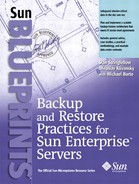Managerial Issues
Implementing a backup and restore architecture scalable enough to meet current and future business needs requires broad support for the project. Depending on the organizational structure of the business, a diverse set of people and interests will need to be brought onboard. The cooperation and approval from different VPs, business units, and operational groups may be required.
Some of the following groups could be involved:
Systems administrators— The persons responsible for planning and implementing backup and restore solutions.
Database administrators— Including DBAs inside and outside the datacenter.
Application development groups— Those responsible for developing internal applications and customizing purchased enterprise applications.
Operations personnel— Those responsible for day-to-day operations of the backup and restore tools.
The system administrators and the database administrators must work together to define responsibilities. The DBAs will want to retain control over database backup and restore procedures. The system administrators will define the ways that file systems are backed up, including files that are created when databases are exported for backup purposes. These two groups should work together to define the backup and restore architecture, evaluate and test the backup and restore tool that will be used, customize the backup and restore tool, and define the operational lines of responsibility.
The mainframe and client/server system administrators need to work together. These two groups should be integrated as much as possible, rather than separated into distinct realms. Integration can increase trust and cooperation.
Negotiations can be carried out to determine service levels for each business unit. Address such issues as how long backed up data must be kept online, which data is critical and which is not, what the backup timeframe will be, and other details. (See “TechEvolve Corp. Case Study” on page 27, for more information on negotiations.) Set up service levels with the various business units and formalize into service-level agreements. The customers of the IT services need to pay for what they are receiving, since service levels imply human, software, and hardware resource costs.
In a rapidly growing enterprise, there may already be an established backup and restore infrastructure and set of procedures; however, the current architecture may no longer be suitable. Several different backup and restore tools may be in use, either purchased or developed in-house. Eventually these tools could reach their limitations in terms of scalability or may become too unwieldy to handle the growing needs of the enterprise.
The solution is to consolidate under a highly scalable toolset and architecture. All groups using the legacy tools will need to agree on their use to make this consolidation successful. This agreement could involve tradeoffs, so everyone involved should be informed of the overall goals. For example, a backup and restore tool developed in-house might serve some purposes well and might be easy to customize for certain groups. But the tool may need to be replaced with a standardized tool in the interest of overall efficiency. Everyone involved should understand the larger goals and be prepared to make some concessions if necessary.
To successfully implement a new backup and restore architecture, develop a plan based on the guidelines in 1, “Methodology: Planning a Backup Architecture” on page 61. All parties affected by the transition should be involved in developing, approving, and implementing the plan.
